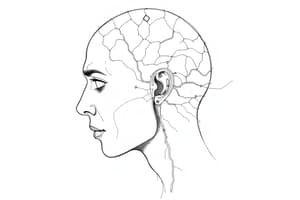Podcast
Questions and Answers
What should a nurse avoid doing when interacting with a client regarding their perspective?
What should a nurse avoid doing when interacting with a client regarding their perspective?
- Using personal examples to relate to the client
- Imposing personal values on the client (correct)
- Encouraging the client to see things differently
- Sharing advice based on personal experiences
Which of the following best describes pain according to the text?
Which of the following best describes pain according to the text?
- A sensory experience only linked to tissue damage
- Existing only when perceived by healthcare providers
- Always associated with actual tissue damage
- An emotional experience associated with tissue damage (correct)
What is the recommended communication approach when addressing a client's pain?
What is the recommended communication approach when addressing a client's pain?
- Speaking slowly and using straightforward language (correct)
- Asking complex questions using medical jargon
- Explaining pain based on medical textbooks
- Using difficult terms to assess pain intensity
What should be considered in gerontologic variations when assessing a client's pain?
What should be considered in gerontologic variations when assessing a client's pain?
Which neurotransmitters are involved in the descending system for pain modulation?
Which neurotransmitters are involved in the descending system for pain modulation?
When assessing a client's pain, why is it essential to avoid personal examples?
When assessing a client's pain, why is it essential to avoid personal examples?
Which part of the brain do the neurons in the descending system send signals to for pain modulation?
Which part of the brain do the neurons in the descending system send signals to for pain modulation?
What nonverbal cues should nurses be mindful of when interacting with clients?
What nonverbal cues should nurses be mindful of when interacting with clients?
What are some factors that can influence a client's perception of pain?
What are some factors that can influence a client's perception of pain?
Which part of the nervous system is responsible for transmitting pain stimuli to the brain?
Which part of the nervous system is responsible for transmitting pain stimuli to the brain?
What is the purpose of a universal pain assessment tool like the one mentioned in the text?
What is the purpose of a universal pain assessment tool like the one mentioned in the text?
In physical assessment, what are the four examination techniques typically used to collect objective data from a client?
In physical assessment, what are the four examination techniques typically used to collect objective data from a client?
What is the key difference between acute pain and chronic pain?
What is the key difference between acute pain and chronic pain?
Which theory of pain suggests that noxious stimuli trigger the release of biochemical mediators or algogenic substances?
Which theory of pain suggests that noxious stimuli trigger the release of biochemical mediators or algogenic substances?
What is a characteristic of chronic pain according to the provided content?
What is a characteristic of chronic pain according to the provided content?
Which neurotransmitter is considered a universal stimulus for pain?
Which neurotransmitter is considered a universal stimulus for pain?
What type of pain can be described as dull, achy, sharp, or burning as per the text?
What type of pain can be described as dull, achy, sharp, or burning as per the text?
Which theory of pain describes the phases of nociception that include transmission, duration, and intensity of pain?
Which theory of pain describes the phases of nociception that include transmission, duration, and intensity of pain?
Study Notes
Pain Management
- Pain can be classified as constant, intermittent, mild, moderate, or severe.
- Peripheral nerve fibers form synapses with neurons in the spinal cord, which ascend to the reticular activating system, limbic system, thalamus, and cerebral cortex.
Factors Influencing Pain
- Mechanical, chemical, and thermal stimuli can trigger pain.
- Psychological factors, such as past experience, depression, and anxiety, can influence pain perception.
- Physiological factors, such as age and gender, can also affect pain.
- Cultural background can modulate pain perception.
Modulation of Pain
- The descending system involves neurons in the brain stem sending signals back down to the dorsal horn of the spinal cord.
- Endogenous opioids (endorphins or enkephalins), serotonin, and norepinephrine are involved in pain modulation.
Pain Assessment
- Assessing pain involves the client's description of pain, factors that influence pain, and response to pain relief strategies.
- Pain assessment scales, such as the Eloisa scale, are used to measure pain.
Physical Assessment
- Physical assessment is a systematic way of collecting objective data from a client using four examination techniques.
- Transduction, transmission, perception, and modulation are the four stages of pain processing.
- Theories of pain include intensity theory, Cartesian theory, specificity theory, and gate control theory.
Types of Pain
- Acute pain lasts only through the expected recovery period and does not last longer than six months.
- Chronic pain is ongoing and lasts longer than six months.
- Cancer pain can be dull, achy, sharp, or burning.
- Other types of pain include radiating pain, referred pain, intractable pain, and phantom pain.
Nociceptors and Pain Receptors
- Nociceptors are classified into somatic, visceral, and neuropathic receptors.
- Noxious stimuli trigger the release of biochemical mediators or algogenic substances, such as bradykinin, prostaglandin, serotonin, histamine, and substance P.
Communication and Assessment
- Avoid using leading questions or multiple-choice questions that may confuse the client.
- Acknowledge the client's right to express their pain experience.
- Nonverbal communication, such as body language and voice tone, is important in pain assessment.
- Special considerations, such as gerontologic variations, should be taken into account when assessing pain.
Studying That Suits You
Use AI to generate personalized quizzes and flashcards to suit your learning preferences.
Description
Explore the mechanisms of pain perception, factors influencing pain, and the modulation of pain through the descending system. Learn about how peripheral nerve fibers transmit pain stimuli and how the brain processes these signals at different levels.





